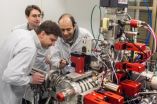(Press-News.org) MINNEAPOLIS/ST. PAUL (March 5, 2013) – Researchers at the University of Minnesota's Lillehei Heart Institute have combined genetic repair with cellular reprogramming to generate stem cells capable of muscle regeneration in a mouse model for Duchenne Muscular Dystrophy (DMD).
The research, which provides proof-of-principle for the feasibility of combining induced pluripotent stem cell technology and genetic correction to treat muscular dystrophy, could present a major step forward in autologous cell-based therapies for DMD and similar conditions and should pave the way for testing the approach in reprogrammed human pluripotent cells from muscular dystrophy patients.
The research is published in Nature Communications.
To achieve a meaningful, effective muscular dystrophy therapy in the mouse model, University of Minnesota researchers combined three groundbreaking technologies.
First, researchers reprogrammed skin cells into "pluripotent" cells – cells capable of differentiation into any of the mature cell types within an organism. The researchers generated pluripotent cells from the skin of mice that carry mutations in the dystrophin and utrophin genes, causing the mice to develop a severe case of muscular dystrophy, much like the type seen in human DMD patients. This provided a platform that would mimic what would theoretically occur in human models.
The second technology employed is a genetic correction tool developed at the University of Minnesota: the Sleeping Beauty Transposon, a piece of DNA that can jump into the human genome, carrying useful genes with it. Lillehei Heart Institute researchers used Sleeping Beauty to deliver a gene called "micro-utrophin" to the pluripotent cells they were attempting to differentiate.
Much like dystrophin, human micro-utrophin can support muscle fiber strength and prevent muscle fiber injury throughout the body. But one key difference between the two is in how each is perceived by the immune system. Because dystrophin is absent in muscular dystrophy patients, its presence can prompt a devastating immune system response. But in those same patients, utrophin is active and functional, making it essentially "invisible" to the immune system. This invisibility allows the micro-utrophin to replace the dystrophin and progress the process of building and repairing muscle fiber within the body.
The third technology utilized is a method to produce skeletal muscle stem cells from pluripotent cells – a process developed in the laboratory of Rita Perlingeiro, Ph.D., the principal investigator of the latest study.
Perlingeiro's technology involves giving pluripotent cells a short pulse of a muscle stem cell protein called Pax3. The Pax3 protein pushes the pluripotent cells to become muscle stem cells, and allows them to be expanded exponentially in number. The Pax3-induced muscle stem cells were then transplanted back into the same strain of muscular dystrophy mice from which the pluripotent stem cells were originally derived.
Combined, the platforms created muscle-generating stem cells that would not be rejected by the body's immune system. According to Perlingeiro, the transplanted cells performed well in the dystrophic mice, generating functional muscle and responding to muscle fiber injury.
"We were pleased to find the newly formed myofibers expressed the markers of the correction, including utrophin," said Perlingeiro, a Lillehei endowed scholar within the Lillehei Heart Institute and an associate professor in the University of Minnesota Medical School. "However, a very important question following transplantation is if these corrected cells would self-renew, and produce new muscle stem cells in addition to the new muscle fibers."
By injuring the transplanted muscle and watching it repair itself, the researchers demonstrated that the cell transplants endowed the recipient mice with fully functional muscle stem cells.
This latest project from the U of M provides the proof-of-principle for the feasibility of combining induced pluripotent stem cell technology and genetic correction to treat muscular dystrophy.
"Utilizing corrected induced pluripotent stem cells to target this specific genetic disease proved effective in restoring function," said Antonio Filareto, Ph.D., a postdoctoral fellow in Perlingeiro's laboratory and the lead author on the study. "These are very exciting times for research on muscular dystrophy therapies."
These studies pave the way for testing this approach in reprogrammed human pluripotent cells from muscular dystrophy patients.
According to Perlingeiro, "Developing methods to genetically repair muscular dystrophy in human cells, and demonstrating efficacy of muscle derived from these cells are critical near-term milestones, both for the field and for our laboratory. Testing in animal models is essential to developing effective technologies, but we remained focused on bringing these technologies into use in human cells and setting the stage for trials in human patients."
###
This study was funded by NIH grants RC1AR059118, AR05529, HL085840-01 and U01 HL100407. Also contributing were the Muscular Dystrophy Centre Core Laboratories P30-AR0507220, The Dr. Bob and Jean Smith Foundation, and the Greg Marzolf Jr. Foundation.
The University of Minnesota Medical School, with its two campuses in the Twin Cities and Duluth, is a leading educator of the next generation of physicians. Our graduates and the school's 3,800 faculty physicians and scientists advance patient care, discover biomedical research breakthroughs with more than $180 million in sponsored research annually, and enhance health through world-class patient care for the state of Minnesota and beyond. Visit http://www.med.umn.edu to learn more.
U of M researchers utilize genetically corrected stem cells to spark muscle regeneration
2013-03-05
ELSE PRESS RELEASES FROM THIS DATE:
The Joint Facial and Invasive Neck Trauma (J-FAINT) Project, Iraq and Afghanistan 2003-2011
2013-03-05
Alexandria, VA — With over 37,000 face and neck injuries in more than 7,000 military personnel during Operations Iraqi Freedom (OIF) and Enduring Freedom (OEF), a new study in Otolaryngology–Head and Neck Surgery concludes additional training in the management of these injuries and improvements in body armor could be beneficial.
The authors note that OIF and OEF have changed the way military surgeons approach facial and penetrating neck trauma. "This study highlights the need for a trained head and neck surgeon in the deployed environment to address these changes and ...
Comparison investing: Why are consumers more willing to take risks when they can compare products?
2013-03-05
Consumers are more willing to take risks and accept delays in exchange for greater benefits when they are able to compare products, according to a new study in the Journal of Consumer Research.
"Rationally speaking, consumer preferences should be the same whether their product choices are presented side-by-side and evaluated comparatively or presented one at a time and evaluated in isolation, but it makes a remarkable difference in consumer decision-making," write authors Christopher K. Hsee (University of Chicago Booth School of Business), Jiao Zhang (University of Miami), ...
Targeting diet products: Why are more independent consumers better at delaying gratification?
2013-03-05
Product benefits that occur later in time are more likely to appeal to more independent consumers than to those who are more group or family oriented, according to a new study in the Journal of Consumer Research.
"More independent consumers think of the future in abstract terms and perceive future events as happening in the more distant future, whereas consumers who are less independent think of the future in concrete terms and perceive future events as happening sooner," write authors Gerri Spassova (Monash University) and Angela Y. Lee (Kellogg School of Management, ...
Texas A&M research contributes to improved ultrasound imaging
2013-03-05
Ultrasound technology could soon experience a significant upgrade that would enable it to produce high-quality, high-resolution images, thanks to the development of a new key material by a team of researchers that includes a professor in the Department of Biomedical Engineering at Texas A&M University.
The material, which converts ultrasound waves into optical signals that can be used to produce an image, is the result of a collaborative effort by Texas A&M Professor Vladislav Yakovlev and researchers from King's College London, The Queen's University of Belfast and ...
On the trail of mucus-eaters in the gut
2013-03-05
This press release is available in German.
The microbiology team of David Berry, Alexander Loy and Michael Wagner from the Faculty of Life Sciences, in collaboration with scientists at the Max F. Perutz Laboratories (University of Vienna and the Medical University of Vienna) and with the help of NanoSIMS technology, has for the first time succeeded in directly observing microorganisms feeding on the intestinal mucosa. The results of this research project appear in the current issue of the prestigious journal "Proceedings of the National Academy of Sciences" (PNAS).
To ...
Homes in neighborhoods with protected open space bringing higher sale prices
2013-03-05
Homes in neighborhoods that incorporate protected open space command prices 20 to 29 percent higher than those without open space, according to a new study by a Colorado State University multidisciplinary research team that included Wildlife Conservation Society scientist, Sarah Reed.
Conservation development is an approach to the design, construction, and stewardship of a development that protects natural resources while also providing social and economic benefits to people. The properties in this study specifically incorporated protected open space into the design of ...
A window into Europa's ocean lies right at the surface
2013-03-05
PASADENA, Calif.—If you could lick the surface of Jupiter's icy moon Europa, you would actually be sampling a bit of the ocean beneath. So says Mike Brown, an astronomer at the California Institute of Technology (Caltech). Brown—known as the Pluto killer for discovering a Kuiper-belt object that led to the demotion of Pluto from planetary status—and Kevin Hand from the Jet Propulsion Laboratory (JPL) have found the strongest evidence yet that salty water from the vast liquid ocean beneath Europa's frozen exterior actually makes its way to the surface.
The finding, based ...
U of M researchers find wide variation in cesarean delivery rates among US hospitals
2013-03-05
MINNEAPOLIS/ST. PAUL (March 4, 2013) – Cesarean delivery is the most common surgery in the United States, performed on 1.67 million American women annually. Yet hospital cesarean rates vary widely according to new research from the University of Minnesota's School of Public Health.
The latest study, appearing today in Health Affairs, shows that cesarean delivery rates varied tenfold across U.S. hospitals, from 7.1 percent to 69.9 percent.
To arrive at their results, School of Public Health researchers examined hospital discharge data from a representative sample ...
Survey of clinicians: User satisfaction with electronic health records has decreased since 2010
2013-03-05
March 5. 2013 -- Survey results released today indicate that satisfaction and usability ratings for certified electronic health records (EHRs) have decreased since 2010 among clinicians across a range of indicators. Overall, user satisfaction fell 12 percent from 2010 to 2012. Users who are "very dissatisfied" increased 10 percent during the same time period.
The American College of Physicians (ACP) and AmericanEHR Partners revealed the findings in a presentation, "Challenges with Meaningful Use: EHR Satisfaction & Usability Diminishing," at the 2013 HIMSS Conference ...
Hope in stopping melanoma from spreading: Inhibiting protein prevents metastasis to lungs in mice
2013-03-05
SALT LAKE CITY – Researchers have identified a critical protein role in the metastasis of melanoma, the most serious form of skin cancer. Inhibition of the protein known as adenosine diphosphate ribosylation factor 6 (ARF6) reduces the spread of melanoma to the lungs in mice, according to a study published in the March 5 issue of Science Signaling online, suggesting that targeting ARF6 may be an effective approach to preventing melanoma metastasis.
Melanoma is the sixth most common cancer in the United States. Approximately one in 50 people will develop melanoma in their ...


